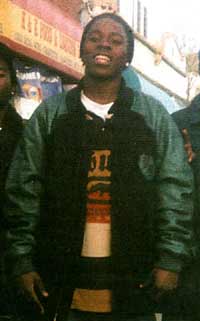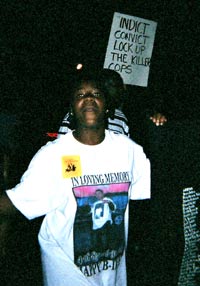Revolution #98, August 19, 2007
Outrage and Protest in Chicago’s West Side
18-Year-Old Black Youth Shot in the Back—Killed by Cops
|
On the evening of August 6, sometime around 8, the life of 18-year-old Aaron Harrison ended in an alley on Chicago’s west side. Shot by a police officer. Sandra Shannon, Aaron Harrison's aunt, told Revolution, “He was home for five days. He was on two years probation. He was scared. He was running for his life. Kids shouldn't have to fear for their life."
Shocked, stunned, outraged—hundreds of mostly young people from the North Lawndale neighborhood took to the streets. Dozens of squad cars blocked off streets around the area. Chicago authorites say that rocks and bottles were thrown at police. Chanting “no justice, no peace, no racist police,” people marched to the nearby police station. The police arrested five people and used mace. A photographer from the Chicago Tribune had two cameras broken by a cop.
Police officials claim that cops saw Aaron doing something suspicious with his waistband before they chased him. They insisted that Aaron was NOT shot in the back but in the shoulder, and that he was armed and pointing a gun at them. The police insisted on this even after the initial report from the medical examiner said that Aaron was shot in the back. The police claim that they recovered a 9mm weapon near Aaron's body. But "finding" a gun doesn't answer the more important question of its origins. A number of witnesses insist that they saw police officers take a bag from the trunk of a police car and leave a gun by Aaron's body.
The August 11 Chicago Sun-Times reported that Cook County Chief Medical Examiner Nancy Jones "confirmed" that Aaron Harrison was shot in his left shoulder, offering the explanation that their initial story that he was shot in the back actually referred to being shot in the top of the left shoulder, which is considered a part of the back. According to the article, Jones claimed that "the wound is consistent with what the officers are saying about the body being turned to them." Ashunda Harris, an aunt of Aaron Harrison, viewed Aaron's body in the morgue. She told Revolution that she saw the location of the bullet hole. It was in the upper left part of Aaron's back —not his front —and she disputes the medical examiner’s conclusions. And she told Revolution that numerous witnesses close to the shooting saw that Aaron was shot in the back, and they never saw any gun in Aaron's hand.
Chicago's Mayor Daley tried to deflect criticism of the police by saying that "everyone blames the police" and telling people to "withhold" their judgment. In other words, as Sandra Shannon put it, "shut up."
Aaron Harrison’s shooting is the third death linked to the hands of Chicago police in less than a month. On July 22, Lester "Roni" Struill was found dead in a police station lockup. According to witnesses, cops severely beat him before he was brought to the police station. On August 4, Gefery Johnson was pronounced dead at St. Bernard Hospital after police used pepper spray and two shots from a taser (which can deliver 50,000 volts of electric shock) on him. His family had called 911 when Gefery, who had a history of mental and substance abuse problems, had locked himself in a room. "They actually executed my child," said Gefery's mother, Lula Johnson. "They executed him."
In the days following the Aug. 6 shooting, Black community activists, some pastors, family members, neighborhood residents, and a growing number of supporters from around Chicago have protested and denounced the police killing of Aaron Harrison. There have been marches to the police station, rallies, press conferences, and a town hall meeting to defend witnesses.
At a protest on Aug. 7, Ashunda Harris, spoke powerfully about what the youth face, and the need to stop police brutality and murder: “I'm here about killer cops. I'm here because this has gone too far. [Aaron] is dead but it could have been anyone. There is a national epidemic of police brutality and WE have to stop it. It's not about 15 minutes of fighting. This is about the way we live everyday… You can't take people to jail and beat them up. You can't beat a confession out of people today and expect them to respect you tomorrow. What is going on out here is a violation of our youth. An attack, a rape of our young people. What they do EVERY DAY. This is a national epidemic.”
A woman who came to three days of protests of Aaron Harrison’s shooting said, “You can't keep seeing these things day after day. I came all the way from the south side. I don't even live out west, but I see police doing this every day. Throwing them up against the cars. Making them get on the ground. Look at all the love they scattered when they killed that boy. Look at all the people that are hurting because they scattered that love when they killed him.”
The shooting of Aaron Harrison, and the outbreak of protest that erupted in its wake, took place as the Chicago “city fathers” are trying to clean up the image of the Chicago police while contending to host the 2016 Olympics. After the widely publicized brutal beating of a Polish-immigrant bartender by an off-duty Chicago cop, the Chicago Sun-Times warned, “Chicago, be clear. The whole world is watching. From Mexico to Moscow, CNN has shown the international community the shameful videotape of off-duty Chicago Police Officer Anthony Abbate trying to beat the living daylights out of a female bartender less than half his size….” (Mar 28, 2007).
And Chicago’s bid for the Olympics has the specter of Jon Burge hanging over its head. For decades Burge ran a Chicago police torture chamber where electrodes were applied to the testicles of suspects, people were repeatedly suffocated with plastic bags and covers, and subjected to cattle prods. The city officially admitted that "an astounding pattern of torture" existed, and continue to defend Burge. Mayor Daley was the county state's attorney for many of the years when Burge and the Chicago PD were torturing people.
The city of Chicago sits on top of hundreds and hundreds of thousands of desperate people with no prospects for decent jobs, education, health care, or a life – a situation that is enforced daily and hourly by the police. Scandals or not, the Chicago police lashed out in the aftermath of the protests. Since the murder of Aaron Harrison, 13 young men have been arrested. According to Sandra Shannon, some were arrested as people were gathering for one of the protests. "Right now, they're trying to intimidate the community," said Ashunda Harris. She said that police are arresting "young men that can possibly identify or testify on some of the things taking place in the neighborhood. I think they're trying to discredit their character. If they're constantly locking them up, their credibility becomes less."
On Friday, Aug. 10, there was a protest rally and then 100 to 200 people, including some white and Latino youth, marched again to the police station behind a “Stolen Lives” banner listing the names of 400 people killed by police around the country.
Sandra Shannon spoke about the protests against the police killing of Aaron Harrison: "They thought it was just going to be another person gone and ain't nothing going to be done about it… If it don't stop, who's gonna be the next victim?" There is a need for people from all walks of life to join these protests, and demand an end to police brutality, repression, and the criminalization of a generation.
|
If you like this article, subscribe, donate to and sustain Revolution newspaper.






